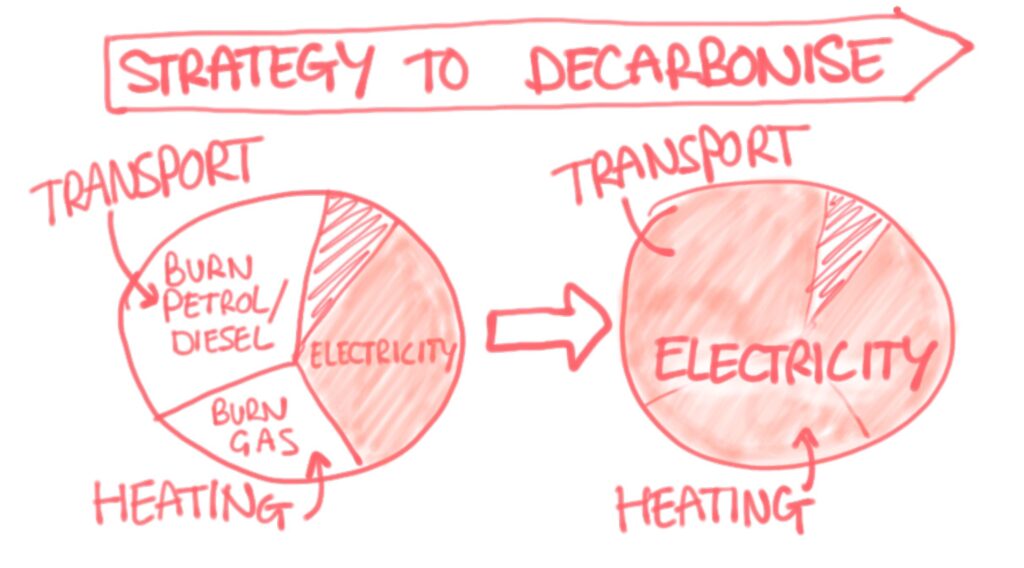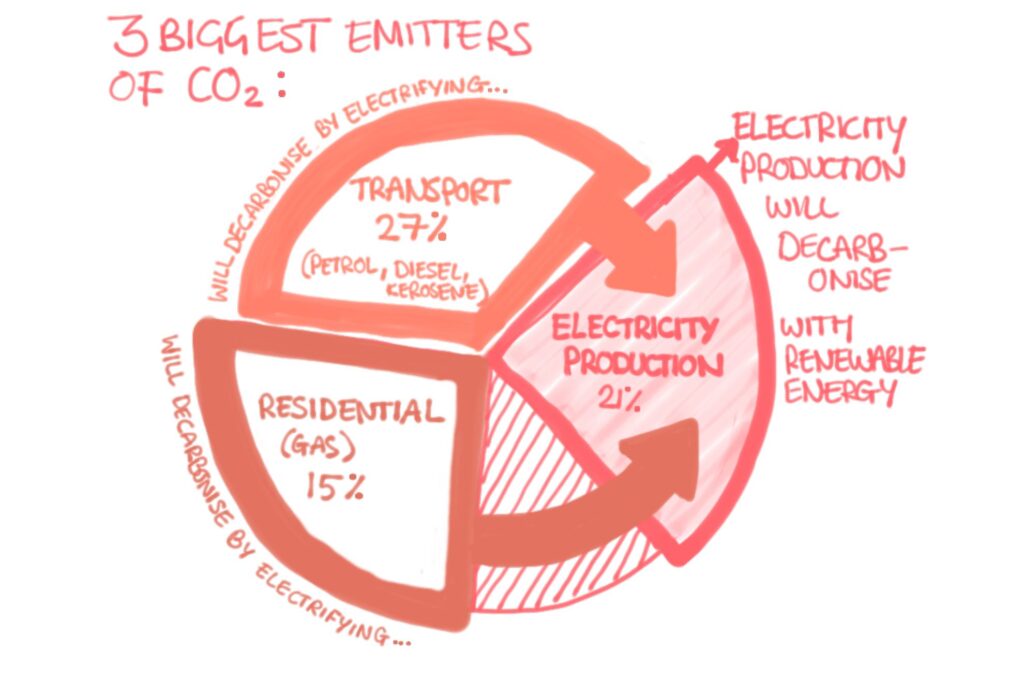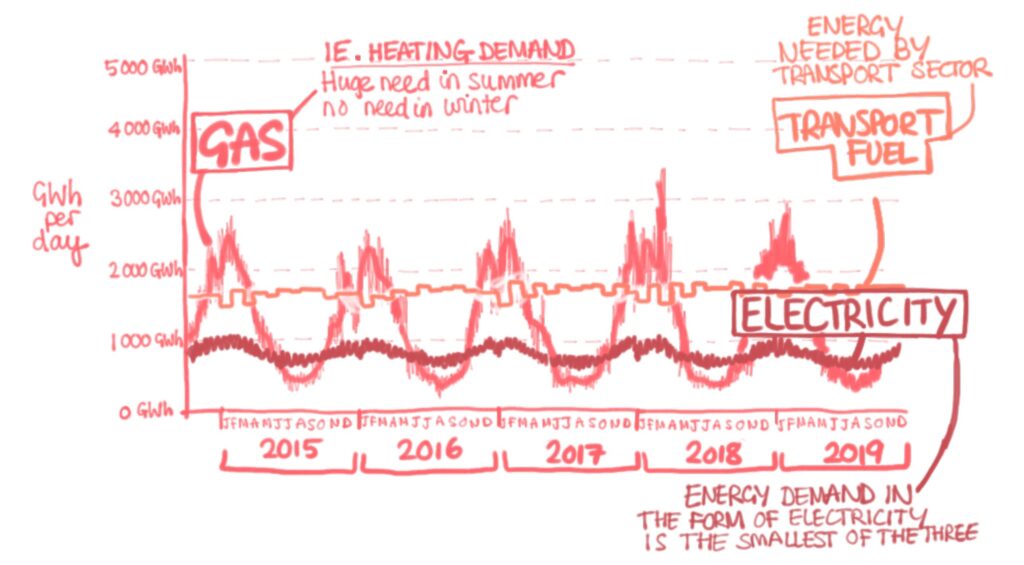This is a big picture posts: Net Zero means that all carbon emissions should be cut back to pre-industrial levels. This is the big goal- how does reaching net zero relate to using renewable electricity?
To reach net zero we need to decarbonise all sectors. That doesn’t mean making fossil fuel sector more efficient- it means finding a totally different way of doing things. People often focus on electricity becoming carbon neutral. We are doing ok at decarbonising the electricity grid in the UK at the moment. There are technologies that can provide clean energy such as wind turbines and solar panels. It’s a slow process and I’ll talk about some challenges in a moment, but we do have ways of making carbon free electricity.
Here’s the crux: electricity is only one of three main sectors emitting greenhouse gases in the UK. The other two are transportation and heating.
Transport…
The transition to electric vehicles will decarbonise road transport. Electric trains already exist widely. Commercial electric planes are still quite futuristic (and they may not even be realistic at all- especially for longer distance flights). Electric boats are also possible for smaller vessels if not container ships.
Either way; the current main strategy to decarbonise transport is to electrify it. If all the road cars in the UK were to become electric today, the electricity demand in the UK would almost double. There is no way the electricity grid could handle it!

Heating…
Residential heating loads are high greenhouse gas (GHG) emitters. That’s because the majority of houses in the UK use gas for space heating, water heating and cooking. Burning gas is directly burning fossil fuels. What are the strategies in this area to decarbonise? Well, we can cook on electric hobs. We can use electric water heaters. And for space heating, although there are electric space heating systems, a much more efficient and ecological way to do it is to use a heat pump. Heat pumps use the natural temperature difference between the outside and the inside as their ‘source’ of energy, and pump refrigerant around a cycle to make the inside even hotter and the outside even cooler (which is fine because it’s outside). It’s a cool technology but the details aren’t important here. The pumping system runs off electricity.
So again, the decarbonisation strategy is to electrify. This would also roughly double the current loads on the grid if everyone switched immediately to electric powered heating.
Emitters of GHGs
Have a look at this sketch below:

We have technology to mostly decarbonise the electricity grid over the coming years, but not if the electricity demand is going to rise 3 fold once the other sectors decarbonise. Electrifying heat and transport is only productive if we use renewable energy. Otherwise we’d still be using greenhouse gasses to run those services indirectly.

In the graph above, you can see the massive seasonal variation in heating demand. At the moment the national grid (that distributes electricity around the country) doesn’t have to handle that because heating still runs off gas. However, as the systems electrify, the giant seasonal variations will become a challenge for the national grid too. Look how much larger the transportation demand is in terms of energy than even electricity! (see the original chart here).
Engineering challenges
So electricity demands are set to increase massively. Let’s look at what this means- what are the engineering challenges in this and what are the solutions? This is an insight into the future of how our country (and world) is going to develop!….
Challenge 1: Getting energy to the right place at the right time
When the wind is blowing, we can produce so much energy- far more than we need. But it’s not always windy. Sometimes, it’s windy in the middle of the night when no-one needs energy. The national grid, the distribution system that bring energy from power stations to our homes, only produces the exact amount of electricity needed by people at every second. It can’t ‘store’ any electricity. So when the wind blows in the night, there’s an engineering challenge to get rid of that electricity somehow so it doesn’t overload and break the grid system. The problem therefore is storing the energy produced during the night for use the following evening when loads are higher. That’s short-term storage.
The second type of storage is seasonal. The loads are so much bigger in the winter than in the summer because of heating….but solar panels produce more electricity in the summer. So we need a way to store electricity over the timespan of a couple of months as well as over the course of day. As we add more renewables, the unpredictability of the grid will be even more drastic.
Challenge 2: Storing the energy
How we store the energy. Batteries don’t work on a large scale. At a small scale (Eg per household) they are becoming affordable but running one unit of energy from a battery is still more expensive than one unit of energy from the national grid, no matter how you charge the battery. So we need other ways. Britain uses hydropower storage already. There’s an example of this is north wales at Dinorwig powerstation. During times when electricity is widely available they pump water to a reservoir up a mountain. When there’s demand for it, it runs down turbines generating electricity. There are other ways to store energy but not yet quite as developed. In other words the technology isn’t 100% ready/affordable. They will be necessary, but we also need solutions now! (that’s the challenge)
Challenge 3: Energy density is worse for renewable energy
Energy density. It takes a lot more land to produce electricity with solar panels than it does producing the same energy storing diesel. Current solar panels convert up to 25% of the solar energy that reaches them into electricity. Sun light is free so this doesn’t really matter but it does take up land space. The same goes for turbines….we will need a lot more wind turbines to create the demand and there will be political/social opposition to that. Often the opposition is to how they look. Since we managed to get used to massive energy pylons running across landscapes, I’m sure we will get used to turbines too. But public opinion can take time to shift…and we need more renewables now!
Challenge 4: Changing habits to suit different energy characteristics
Even if we can store electrical energy; it has very different characteristics to chemical energy. It’s not impossible but it’s a challenge. It currently takes a few minutes to fill up a car with petrol. An electric car takes a few hours to recharge. It’s generally ok for electric cars to do this overnight but when it comes to lorries or something- they need to be running all the time and because the amount of electricity they need is so much higher than a van, it would take so long for them to charge- it just doesn’t work. We need much better batteries, but there’s no clear pathway to that yet.
Conclusions
These topics are worth looking at from a big picture approach. The challenge is big. There are a lot of exciting technologies in development but there’s also no time to wait passively. I have more posts coming on how Britain might deal with these challenges and what our future with Net Zero could look like. There are also posts in the pipelines about what amount of these emissions we should feel personally responsible for as individuals and what is really the responsibility of the government and industry. Along with this there will be posts on the carbon footprints of our lives and how we can use the information productively to live in tune with our conscience.
You may also enjoy last week posts if you haven’t seen is already on carbon emissions vs carbon footprint.
Thanks for reading! Stay tuned for our weekly Tuesday posts and monthly newsletter by email (sign up on website above).

